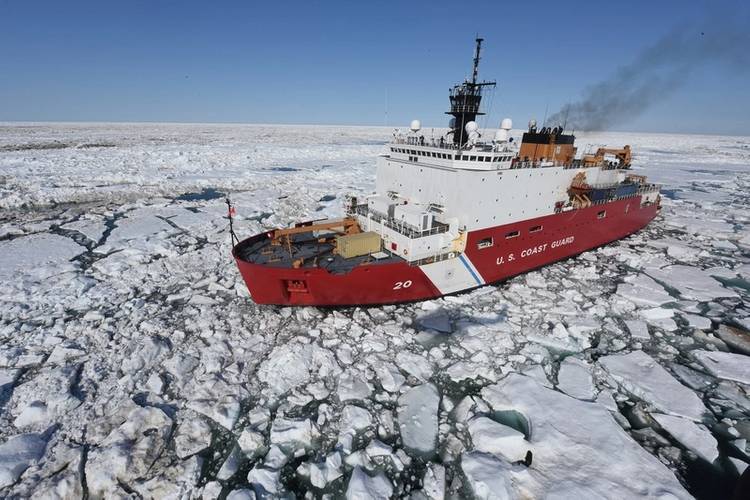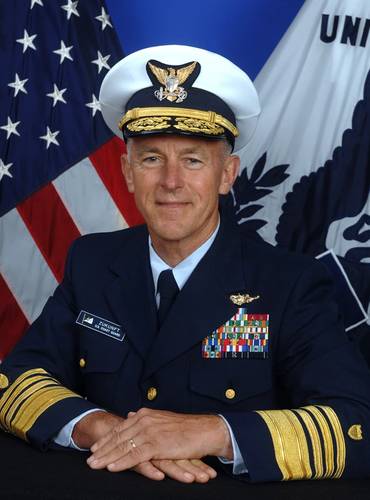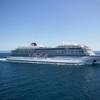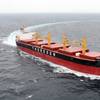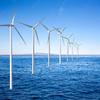U.S. Coast Guard Commandant, Adm. Paul Zukunft presented at last week’s 6th Symposium on the Impacts of an Ice-Diminishing Arctic on Naval and Maritime Operations in Washington, DC.
Summarizing Adm. Zukunft’s speech, Maritime Commons has provided highlights of the Commandant’s remarks on maritime operations in the Arctic
In my role as the Commandant of the Coast Guard, I view the Coast Guard as the lead federal maritime agency when it comes to all things Arctic. By “all things Arctic,” I mean everything from safety of life at sea, to marine environmental protection, to fisheries enforcement and a whole host of Coast Guard missions. They all reside within one service, the United States Coast Guard. We are a one-stop shop.
If you go back to 1867, through Seward’s Folly, we acquired the territory of Alaska from a bankrupt Russia at the cost of two cents per acre. Had it not been for Seward’s Folly, we wouldn’t be an Arctic nation today. If you look at the vast riches in the Arctic, and in the state of Alaska, this was anything but a folly.
Coast Guard oversight
If you’ve been following the news, we recently had a flotilla of Shell’s ships in Seattle and we had a number of ‘kayaktivists’ protesting against this activity. It was incumbent upon the Coast Guard to make sure that a federal waterway was not impeded while at the same time, allowing these activists to demonstrate their Constitutional rights. This brings about an important point. Our job is to protect the waterways as well as this industry but, more importantly, we provide critical oversight of the industry in an area where there is absolutely zero room for failure when you look at drilling in the Chukchi Sea.
Five years ago, I was the federal on scene coordinator for the Deepwater Horizon oil spill. We had 47,000 responders that were marshaled from the Gulf of Mexico. You can’t do that anywhere else but in the Gulf of Mexico. In comparison, we do not have the shore infrastructure to respond to a contingency from the shore in the Arctic today. This is why Shell, assuming they get their final drill permit, has marshaled 26 ships that will work in the Arctic.
We are a service that prides itself on being Semper Paratus, always ready, but the Arctic region really does present a challenge for us. Our icebreaking fleet is two vessels, a medium icebreaker, the Healy, primarily designed to do scientific support activity and one heavy icebreaker, the Polar Star, which can break ice up to 21 feet thick by backing and ramming.
The Coast Guard Cutter Polar Star is the most powerful, non-nuclear powered icebreaker in the world, but it’s also 39 years old. Because of the territory of Alaska, we are an Arctic nation and it’s an area where the Coast Guard has been operating since 1867. We’ve been building relationships and now, as we chair the Arctic Council, we also have an opportunity of working in this area multilaterally.
What we’ve done
We’ve done an extensive amount of research and outreach and now have an Arctic Coast Guard Forum comprised of all eight Arctic Council nations. This was created under the chairmanship of Canada, when they chaired the Arctic Council. We really divorced the Arctic Council and the Arctic Coast Guard Forum so we can look at a whole host of potential emerging issues as we see them evolving over the next century and beyond. We have a model that we are replicating right now. One is called a North Pacific Coast Guard Forum. We now have:
- A Coast Guard Hamilton class cutter on the far western reaches of the northern pacific with Chinese ship riders embarked
- Canada flying surveillance flights
- Coast Guard flying surveillance flights based out of Japan
- Russia sharing information with us looking for vessels engaged in high-speed drift net fishing
Joint operations
Between Canada, the United States, Korea, Japan, Russia and China we’ve been able to work collaboratively doing joint operations and we’ve been doing this for the last 12 years.
When Canada chaired the Arctic Coast Guard Forum, under their foreign policy, Russia was not allowed to participate in any of these discussions relating to the forum. I’m pleased to say that working through our Department of State, two and a half months ago, we were able to bring a Russian delegation to our Coast Guard Headquarters and all of the members of the Arctic Council as we laid out the groundwork for an Arctic Coast Guard Forum. To take that one step further, this fall we will conduct a tabletop search and rescue exercise among all of the Arctic Coast Guard Council nations to work on communications, determine who responds to what, build upon this tabletop exercise and conduct an actual exercise next year to replicate what I see is probably the predicable surprise; a mass rescue in the Arctic region. Now why is that?
Ice rescue operations
We know that on the Atlantic side that this year over 200,000 cruise ship passengers will travel north of 60 degrees north. Much of that area is ice free but what are the charting standards in the Arctic domain? About five percent of the Arctic is charted to what we call 21st century standards. If you look at an earlier chart, and the retreat of ice, we lifted the ‘lid off the ocean’ but what is underneath is a bit of a dilemma for us.
There is a sea mountain named after the Coast Guard Cutter Healy. It’s called the ‘Healy Sea Mount’ and it rises 10,000 feet from the sea floor. It had not been discovered until Cutter Healy found it about 10 years ago. They discovered it with their side-scan sonar.
These 200,000 passenger cruise ships are using charts with data that goes back to 1915 from the Earnest Shackleton era when the last depth surveys were recorded. I was recently on an Icelandic Coast Guard vessel ‘Thor.’ While on this vessel, I met with the Captain. I asked him how many years of sea duty he had. He had 52 years of sea duty! I asked him – as you’re navigating up in this area, how do you mitigate risk? As Thor is underway, they use a small boat with a portable side-scan sonar in front of the ship to make sure there isn’t shoal water in front of them. As they’re navigating along, the cruise ship will steam by at 20 knots because they have to meet a schedule. When I look at that predictable surprise, I have to ask what we would do if we had a mass rescue scenario in the Arctic domain?
To mitigate and plan for these risks, we will be doing a tabletop exercise this fall. It is my intent that we will actually deploy assets and build these relationships going forward. We will host a summit meeting of the Arctic Coast Guard Forum at the Coast Guard Academy this fall as well. It’s the one area where I can speak with my counterparts from Russia.
When I talk to the other service chiefs, their dialogue with their Russian counterparts has been strained or severed with our policy toward Russia right now. But if you look at how we shape the environment of the Arctic and what is it that really matters to each member of the Arctic Council nations, we need to be mindful of a number of factors: the indigenous tribes and human activity, safety of life at sea, sovereignty issues and, most importantly, the environment.
Fisheries
Fisheries are starting to migrate further north. I am fascinated by where the fish migrate because we have a moratorium against fishing up there right now. When I look at the work that the Healy has done and working with international partners as well, we’ve done extensive mapping offshore beyond our extended continental shelf. So much so that roughly about a million square kilometers, which equates to roughly twice the size of the state of California, is technically sovereign U.S. waters beyond our 200 mile economic exclusive zone.
Marine environmental protection
When I get my daily intelligence briefs, I’m fascinated by where Korea and China are doing scientific research. Coincidentally, it happens to be in our extended continental shelf which we haven’t fully claimed yet and, absent a ratification of the Law of the Sea Convention, we need to come up with imaginative ways of not losing our sovereign rights over what is rightfully United States’ extended continental shelf claims.
We have a number of other countries claiming up to the North Pole; there’s a bit of a land grab if you will. If you look within our exclusive economic zone and extended continental shelf, it contains about 13 percent of the world’s unexploited oil, 30 percent of the world’s natural gas and about a trillion dollars worth of minerals on the seabed. While technology may not afford a means to extract that today, we need to take the long view.
We need a presence in the Arctic for safety of life at sea, marine environmental protection, coordinating a response in the Arctic domain, and yes…you might have to exert U.S. sovereignty. We need to be there as an enforcement arm. We need to be there to provide a necessary check and balance for private sector as they exploit these riches. There is zero room for failure, and by that I mean an oil spill in the Arctic. We’ve worked very closely with the Department of Interior and the Bureau of Safety and Environmental Enforcement as we ask, ‘what is a worst case discharge?’ when it comes to drilling in the Chukchi Sea.
This was a valuable lesson we learned from Deepwater Horizon because an oil spill response plan was based on the amount of fuel that was carried on the drill rig. It didn’t take into account the drill pipe that goes into the reservoir containing, in this case, over two million barrels of oil that was released. So we are working collectively to determine what the worst case discharge might be if Shell were to have a loss of well control in the Chukchi Sea? It’s something we have to have a very open and frank dialogue about. If approved, Shell will have 26 ships operating up in the Arctic to include a containment device, a capping stack and all of the recovery materials necessary for the potential for release of oil in the Arctic. As the responsible party, it is their responsibility. It is not the responsibility of the federal government. If they don’t exercise due diligence, then we will take over that response. Shell has made a front-end investment to deal with a worst-case discharge.
We are still learning about the Arctic and science is absolutely critical. During the response to Deepwater Horizon, we applied more of the dispersant Corexit 9500 than we ever dreamed of applying. You have about a 24-hour cycle where you can apply this dispersant in order for it to be effective. We really struggled with whether it was pragmatic and responsible for us to use dispersants or watch raw oil coming on days when we couldn’t skim or couldn’t burn because the sea conditions were too rough and then watch all that oil come into our nation’s wetlands where about 47 percent of our wetlands are in the state of Louisiana which is really a big part of the ecosystem for the entire Gulf Coast.
So these are the tradeoff decisions that we have to make and in a very nimble manner. Eventually, the federal on scene coordinator has to make judgment calls based upon the best information available. We need further scientific research in the Arctic. We need to know the health of the Arctic as it sits today, especially as we see an increase in human activity. Our old icebreakers don’t meet the provisions from a MARPOL standpoint or from the Polar Code; they leave a sooty-footprint wherever they go. They don’t have a holding tank capacity but we are pressing industry to meet some very stringent standards up in the Arctic and those standards are only going to increase over a period of time.
Coast Guard icebreakers
So what keeps me awake at night?
Let’s take a look at our nation’s icebreaking fleet.
Last year we sent the Coast Guard Cutter Polar Star down to Antarctica to respond to two ships beset by ice. The Snow Dragon, a medium-icebreaker that can break ice maybe 8 feet thick, and the MV Akademik Shokalskiy, a Russian, ice-capable, eco-tourist, scientific work vessel. The Snow Dragon was in the area to assist the MV Akademik Shokalskiy. Both vessels became beset in ice. We recalled the Polar Star to come to their rescue. As fate would have it, the wind shifted and both vessels were able to extract themselves. This is just one demonstration of the value of why we need national assets, not Coast Guard assets, to do this very unique mission.
The Coast Guard Cutter Healy took off from the North Slope yesterday. She’s launching unmanned aerial systems using thermal imaging as we look at doing search and rescue and safety of life at sea from the northern regions. The Healy has about 50 scientists onboard doing work for the National Science Foundation.
A number of years ago, the Healy deployed to break into Nome when they couldn’t get their fuel delivery. That fuel was shuttled in by an ice-capable Russian tanker. I don’t think that contingency plan would play out so well if Nome runs out of fuel this next winter.
When the Polar Star came back this last year, we had a New Zealand fishing vessel beset in ice over 150 miles just north of Antarctica in ice 15 to 16-feet thick. The vessel had sheered both of its propellers. We diverted the Polar Star. They were able to extract this vessel but on the way in, I asked myself what if this 39-year-old ship suffers an engineering casualty? Who comes to their rescue? We’ve always had two operational heavy icebreakers to have that buddy system. Right now, with one medium and one heavy icebreaker, when one is operating the other is being maintained and vice versa. The United States currently has no self-rescue capability in the higher latitudes. For me, that is not a good risk position to put our country or our crewmembers in. When the Polar Star returned from Operation Deep Freeze, they immediately went to a yard because these operations really wear out a ship. A lot of works needs to be done. Right now, that crew has been away from home for 270 days. In a two-year period, this crew will be underway for the next 500 days. Right now, we are bearing this burden on the backs of these young men and women who are the only ice captains, the only Arctic experienced folks operating in this domain short of the Healy, which is why we are looking at we need to recapitalize in the Arctic.
The United States really isn’t even in this game. I use a Sputnik comparison. When Russia put Sputnik into space, did we sit with our hands in our pockets with great fascination and say, ‘good for Russia?’
We have eight times the gross domestic product of Russia yet Russia has a fleet of over 25 ocean going icebreakers and they are building six new nuclear icebreakers. Here we are, trying to cobble together a reactivate a 39-year-old icebreaker because that’s the best that we can do. I’m here to say we need to do better.
Conclusion
The good news is we have not let up on beating this drum and it is resonating. What better time than with the Arctic Council, to really put our best foot forward. If we are fully vested in the Arctic, we’re not doing so with any significant amount of presence. Under these circumstances, we are an Arctic nation in name only and not by deed. Tremendous challenges abound in being Semper Paratus in the Arctic and the United States cannot withstand a lull. It is imperative that we have relationships with the Arctic Council nations as we look at the challenges going forward and how we leverage science.
How we stay in tune with the indigenous tribes that are up there? We have an opportunity to shape this domain. The Arctic is opening up and that is the reality that we need to face.
We have a strategy for the Arctic and my job is to implement and get things done. That is my imperative as we go forward. We’ll be doing a search and rescue exercise and a marine environmental response tabletop exercise as well. We are not going to stop at search and rescue. We want to take it this one step further. The more we do these exercises, the more dialogue we have, the more interactions we have, the more trust we build, more collaboration occurs and, at the end of the day, we have unity of effort.
We need to listen to science and make sure we are headed in the right direction.
[Source U.S. Coast Guard Maritime Commons]





